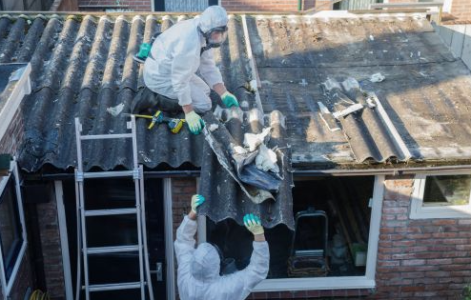Beware of this deadly risk lurking in homes built before 1990
By
VanessaC
- Replies 11
Home renovation can be a rewarding endeavour.
However, for those tackling projects in homes built before 1990, there's a hidden danger that could have deadly consequences.
Asbestos, a once-popular building material, is present in one in three Australian homes.
It is also responsible for approximately 4,000 deaths each year from cancer and other asbestos-related diseases—three times the national road toll.
As the 20th anniversary of Australia's ban on asbestos approaches, it's crucial for homeowners and do-it-yourself renovators to be aware of the health risks associated with this hazardous material.
Not only could you be putting your health at risk, but also that of your family and neighbours who might be exposed during the renovation process.
Despite the ban on asbestos in December 2003, the risks associated with this material are far from over.
The risk of exposure and environmental contamination is also heightened by frequent extreme weather events, such as floods and fires, which can damage structures and release asbestos fibres into the air.
As Paul Bastian, Chair of the Asbestos Safety and Eradication Council, warns, 'Australia is paying a devastating price for our past use of asbestos, having one of the highest death rates of asbestos-related diseases in the world.'
'There is a concern that a growing number of DIY renovators are next in line for exposure and disease.'Bastian encouraged tradespeople and homeowners not to cut corners to save costs.
'Know where asbestos is before starting work, and don’t touch it if you don’t have the training and equipment to remove it safely—use a licensed asbestos professional instead,' he advised.
Homes built before 1990 are particularly likely to contain asbestos, especially in kitchen and bathroom areas. If you're planning a renovation project, having your home inspected for asbestos before you start is essential.
You can find a list of licensed asbestos professional removalists through your state or territory’s work health and safety regulators. Be sure to request for a copy of the removalist’s license, or contact your local work health and safety regulator in your state or territory to confirm if they have the right class of license for the job.
Asbestos was widely used in construction due to its heat resistance, strength, and insulating properties. It can be found in millions of buildings and structures across Australia, including in roofing, flooring, and wall materials.
The danger lies not in the material itself but in the tiny fibres that can be released when disturbed or damaged.
These fibres can be inhaled and become lodged in the lungs, leading to serious health problems such as asbestosis, lung cancer, and mesothelioma.
Asbestos-related diseases often take many years to develop, so you might not realise you've been exposed until it's too late.
Symptoms include shortness of breath, a persistent cough, chest pain, and unexplained weight loss.
If you've been exposed to asbestos and experience any of these symptoms, it's crucial to seek medical advice immediately.
 Have you encountered asbestos during your home renovation projects? Share your experiences and tips in the comments below.
Have you encountered asbestos during your home renovation projects? Share your experiences and tips in the comments below.
However, for those tackling projects in homes built before 1990, there's a hidden danger that could have deadly consequences.
Asbestos, a once-popular building material, is present in one in three Australian homes.
It is also responsible for approximately 4,000 deaths each year from cancer and other asbestos-related diseases—three times the national road toll.
As the 20th anniversary of Australia's ban on asbestos approaches, it's crucial for homeowners and do-it-yourself renovators to be aware of the health risks associated with this hazardous material.
Not only could you be putting your health at risk, but also that of your family and neighbours who might be exposed during the renovation process.
Despite the ban on asbestos in December 2003, the risks associated with this material are far from over.
The risk of exposure and environmental contamination is also heightened by frequent extreme weather events, such as floods and fires, which can damage structures and release asbestos fibres into the air.
As Paul Bastian, Chair of the Asbestos Safety and Eradication Council, warns, 'Australia is paying a devastating price for our past use of asbestos, having one of the highest death rates of asbestos-related diseases in the world.'
'There is a concern that a growing number of DIY renovators are next in line for exposure and disease.'Bastian encouraged tradespeople and homeowners not to cut corners to save costs.
'Know where asbestos is before starting work, and don’t touch it if you don’t have the training and equipment to remove it safely—use a licensed asbestos professional instead,' he advised.
Homes built before 1990 are particularly likely to contain asbestos, especially in kitchen and bathroom areas. If you're planning a renovation project, having your home inspected for asbestos before you start is essential.
You can find a list of licensed asbestos professional removalists through your state or territory’s work health and safety regulators. Be sure to request for a copy of the removalist’s license, or contact your local work health and safety regulator in your state or territory to confirm if they have the right class of license for the job.
Asbestos was widely used in construction due to its heat resistance, strength, and insulating properties. It can be found in millions of buildings and structures across Australia, including in roofing, flooring, and wall materials.
The danger lies not in the material itself but in the tiny fibres that can be released when disturbed or damaged.
These fibres can be inhaled and become lodged in the lungs, leading to serious health problems such as asbestosis, lung cancer, and mesothelioma.
Asbestos-related diseases often take many years to develop, so you might not realise you've been exposed until it's too late.
Symptoms include shortness of breath, a persistent cough, chest pain, and unexplained weight loss.
If you've been exposed to asbestos and experience any of these symptoms, it's crucial to seek medical advice immediately.
Key Takeaways
- Renovators are being warned about the dangers of asbestos in pre-1990 homes, as it poses a significant health risk and leads to around 4,000 deaths each year in Australia.
- Asbestos is found in one in three houses across Australia, and exposure and environmental contamination have also increased due to frequent extreme weather events.
- Asbestos Safety and Eradication Council Chair Paul Bastian has highlighted a growing concern for DIY renovators who could be exposed to asbestos and, in turn, face related diseases.
- Bastian advises homeowners and tradespeople to use a licensed professional to remove asbestos, especially in homes built before 1990 that are likely to have asbestos-containing materials.
- Renovators can find a list of licensed asbestos professional removalists through the website of their state or territory’s work health and safety regulators.








